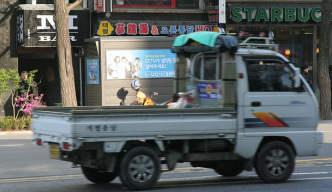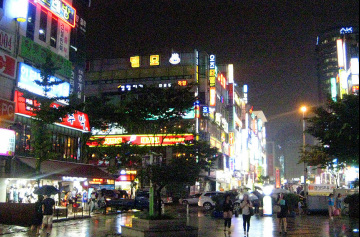These memories are vivid, even as I sit here in the spring of 2013, four years later.
Part I: “A Pig Virus Delays My Arrival“
I was relieved. I’d found the woman without problem. I exchanged some dollars for Korean won. We went out. I didn’t rent a phone. I didn’t yet know I could rent a phone at the airport, and I couldn’t have known that I wouldn’t be able to otherwise get a phone in my name until I had my Alien Registration Card (ARC), and I couldn’t have known that the ARC would be a while in coming. It was late June before I got a phone. I was phoneless quite a while.
Back on the evening of April 29th, 2009, though, I was too busy being amazed by things to care about all that.
So many things amazed me. One thing especially stands out clearly in my mind’s eye: The cars in the parking lot all seemed to have retractable side-view mirrors — that is, the mirrors folded-in automatically when the car turned off. Amazing, I thought. I concluded that it must be because space is at such a premium in Korea (being that South-Korea is the size of Indiana and something like 75% mountainous, as I later learned). I remarked to Melinda that the cars in the USA didn’t have automatically-retracting side mirrors. She seemed puzzled.
 Walking off the plane in April of 2009,
Walking off the plane in April of 2009,
I thought that most Korean automobiles
would be something like this. / (From here)
I really thought Korea would be filled with those narrow trucks (like the one I found at right) and the like. I thought most cars would resemble the Hyundai Pony. In hindsight, this seems truly naive, to the point of stupidity: Didn’t I know South-Korea was now among the richest countries on Earth? In defense of my 2009-self: Okay, South-Korea is rich, but Germany is even richer, and Germans’ cars are generally on the small side, as I remember clearly.
We were racing along, and stopped for gas at one point. The attendant asked, gesturing at me, “Who’s that?” (or so Melinda translated). I was surprised to see gas station attendants at all, a rare sight in today’s USA.
The car navigation system spoke to Melinda steadily, giving directions. Our destination: Ilsan, my home for the next year. Writing from the vantage point of 2013, it’s a place I have fond memories of, though actually living through it was often tough for me.
Ilsan is one of South-Korea’s “New Cities”, which went from rice-fields in 1990 to a more-or-less integral part of the Seoul megalopolis by 2010, when I lived there. It’s northwest of Seoul. Much, or most, of it is closer to the DMZ than to central-Seoul.
Below is a google-map of Ilsan. If you are reading this and have an interest in orienting yourself, to follow along with this meandering narrative, zooming in and out would help. The airport is far off to the southwest. The red-marker is anchored on a park area in central Ilsan, not far from where I lived. Zooming in, this park connects Jeongbal Hill (forested, to the east) with Ilsan’s Lake Park (to the west). Now, in Korean and Chinese, “Il-San” means “one mountain” or “one hill”. I tried for a long time, in vain, to figure out if Jeongbal Hill was that “one”. No one ever seemed to know. My friend Jared, who knows many things like this, had another idea about it referring to a different specific hill, but I’ve forgotten which.
My mind, drawing on previous linguistic experience, was making wild and certainly-wrong linguistic connections on the fly: “Im-nee-dah” sounds a bit like the Estonian word for politely expressing thanks, “aitah”. Perhaps they are connected, I speculated. / [Speaking of Estonian: I have various “go-to” attention-getting / unexpected-change-of-pace mini-activities I use on bored or unmotivated ESL classes: One is to write the numbers one-to-ten on the board in all the languages I know them in (English, Spanish, German, Estonian, Russian, Korean, Chinese-Korean). For the Spanish, German, Estonian, and Russian numbers, I ask students to guess which languages those are. They can typically get Spanish and German quickly, and sometimes can get Russian, but no one ever gets Estonian.]
The car ride continued, as I pondered whether an Estonian-Korean linguistic connection were possible at all.
 Neon lights were novel to me in April 2009.
Neon lights were novel to me in April 2009.
Entire facades of buildings were lit up, as here,
on that night in Ilsan / (From here)
We were stopped at an intersection, waiting to turn. Before us was a large facade full of neon. I asked Melinda what all those signs meant. I was so confused: What could they all possibly be for?! She glanced at them and said that many are the names of hagwon — private educational institutes, mainly for K-12 students.
This dizzying array of neon lights (even more onerous-to-a-Westerner’s-sensibilities than the one I found online at left), meant we’d just about arrived. I didn’t know it yet, though: For all I knew, we’d have to drive through another half hour of this. I had no concept of scale within the Seoul megalopolis.I have more of one now, but it’s hard to truly wrap one’s mind around a 25-million-person urbanized region. / No, we had nearly arrived. No more driving. I’d later learn the informal English-name of the road onto which we were turning: It is commonly called “Hagwon Road”. It parallels the Gyeongui Rail Line.
My eyes had been darting everywhere since I’d gotten in the car. Deja Vu: I remember doing the same in January of 2007, when I arrived in Berlin, the first time I left the USA. In both cases, I was so excited that I tried to catch a glance at everything outside the window. I rued each blink. Seeing all this was a joy of life like few others.
As such, I was almost disappointed when we actually arrived, because it meant I’d no longer be able to be a passive observer, taking-in this new universe into which I was about to stumble. I was about to meet lots of new people, soon-to-be coworkers, and hopefully would impress them. I could not have foreseen that, before the night was over, one of these new people would tell me that I should be “deported”!
After some confusion on where to park, Melinda, the recruiter’s assistant, turned off the car, opened the trunk, and I took my suitcases out. We wheeled them over to the door of the building in which the language-institute was housed. We got in the elevator. She pushed the button. Up we went. . . .
